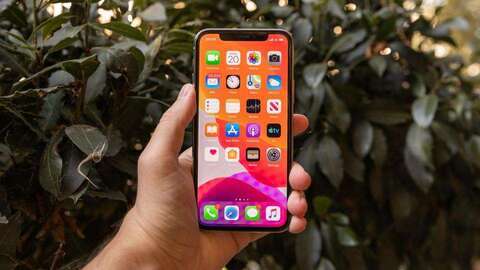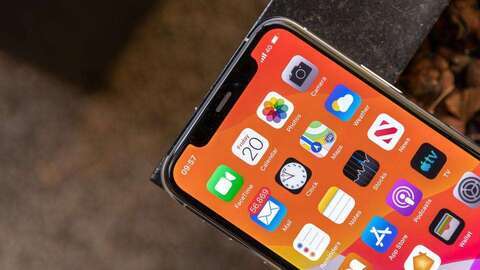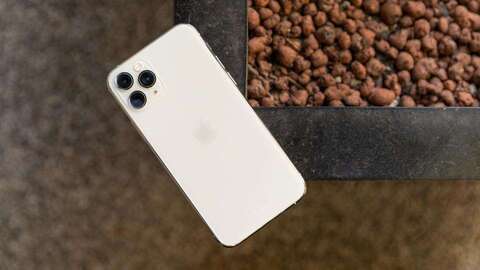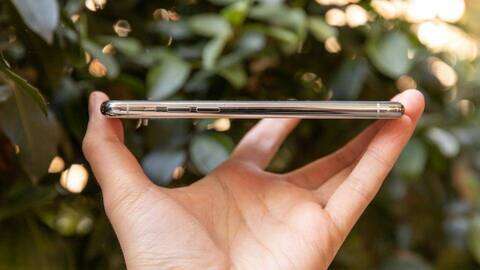Apple iPhone 11 Pro Apple iPhone 11 Pro review: Very nearly the perfect phone
Hands up: I was wrong about the iPhone 11 Pro. Or at least, the design. When I first clapped eyes on it I instinctively didn’t like the look of the thing. That trio of camera lenses looked, to my eyes, awkward – ugly even – peering like some three-eyed Harry Potter out of the rear of the phone.
Now I have one in my hands, however, my opinion has softened somewhat. The square camera bump isn’t quite as prominent as I first assumed it would be and the fact it’s part of the same piece of glass – just with a different finish to the rest of the rear panel – is actually rather clever.
Although he’s long-gone, Jony Ive’s influence can still be seen, hidden in the fine details. Each camera lens is framed boldly in stainless steel, seemingly perfectly positioned in space, each one equidistant from the other. And the camera bump itself is positioned in just the right place, too.
But it’s the rest of the iPhone 11 Pro’s glass rear that proves ultimately persuasive, its matte finish beautifully smooth – a silky texture that feels like beach glass, ground smooth by years of tidal shift.
READ NEXT: Apple iPhone XR review – now £120 cheaper
Apple iPhone 11 Pro review: What you need to know
In reality, although important in its own right, the design of the iPhone 11 Pro plays second fiddle to the tangible improvements Apple has made to rest of the iPhone 11 Pro. And the big feature upgrade for 2019/20 is to the cameras, with one additional ultrawide shooter adding to the primary and 2x telephoto of last year’s S-series iPhones Xs and Xs Max .
Apple has also made a host of other improvements, to the screen, battery life, water-resistance and the performance of the phone, along with the usual extras that go along with a new version of iOS but none trumps that new camera.
Otherwise, it’s very much business as usual. There’s been no change in screen size or form factor for either of the firm’s flagships. The iPhone 11 Pro’s display still measures 5.8in across the diagonal just like the iPhone XS before it, and the iPhone 11 Pro Max’s 6.5in screen matches that of the iPhone XS Max.
Apple iPhone 11 Pro review: Price and competition
There hasn’t been an awful lot of change when it comes to pricing, either, with the new flagships rising a mere £50 in price. The “cheapest” iPhone 11 Pro is now £1,049 for the model with 64GB of storage (no, there’s no microSD expansion) and this price goes up to £1,199 for the 256GB model and £1,399 for the 512GB model. I think, considering the high price, that 64GB on the base model is rather mean but Apple customers must be used to this by now.

Even compared with priciest the Android crop can muster, this remains A LOT OF MONEY, though. The closest in price to the iPhone 11 Pro is our favourite Android flagship, the Samsung Galaxy Note 10+ . This costs £999 currently but is more of a rival for the bigger 6.5in iPhone 11 Pro Max. The Samsung Galaxy S10 is the more natural competitor and that’s over £400 cheaper at around £635 .
If you simply have to have an iPhone but can’t afford the 11 Pro, the iPhone 11 is a good deal cheaper at £729 . You’ll have to learn to live without the Pro’s telephoto camera, AMOLED screen and improved water-resistance, though.
Buy from John Lewis
Apple iPhone 11 Pro review: Design and new features
Aside from its controversial camera housing, the Apple iPhone 11 Pro’s design is nigh on identical to the iPhone Xs. The glass is tougher, says Apple, but the materials on show are the same, with a polished, colour-matched stainless steel frame surrounding the edges of the phone and hardened sapphire crystal topping each of the phone’s cameras.
The notch is still there, stubbornly clinging on despite all the brickbats hurled in its general direction, and it houses the same Face ID setup. The positioning of buttons, antenna bands, speaker grille and charging ports are all the same, too. It’s worth mentioning, though, that the front camera has been boosted to 12-megapixels from the 7-megapixels in the iPhone Xs this year, and that there's a new Midnight Green colour to add to the more familiar Space Grey, silver and gold variants.

The only hardware differences, aside from the big ones noted above, are more subtle. The phone comes with a more powerful 18W mains charger, so it’s quicker to charge than with the 15W one supplied with the XS. It’s also now IP68 dust- and water-resistant, which means it’ll survive encounters with fresh water down to a depth of four metres for up to 30 minutes. So it'll be okay if you drop it in at the deep end of the swimming pool.
Audio has been boosted, with support for Dolby Atmos’ object-based sound from the phone’s stereo speakers, and there’s now also a bigger battery (3,190mAh vs 2,168mAh), which Apple says adds up to four hours to the overall running time of the phone. There’s also now faster cellular connectivity, up to a maximum speed of 1.6Gbits/sec for downloads although not, as yet, any 5G connectivity.
If there’s one feature notable for its absence from the iPhone 11 Pro and, by extension, it’s bigger brother the 11 Pro Max, it’s 3D Touch. In many ways, this isn’t a huge disappointment. Although innovative, I was never convinced Apple made enough use of it. There is one feature I will miss, however: the ability to push down on the keyboard and then drag the cursor around with your thumb.

Apple iPhone 11 Pro review: Display
Apple is well known for its fondness of acronyms and buzzwords and when it comes to its screen technologies, they’re everywhere you look. This year, the iPhone 11 Pro is equipped with a “Super Retina XDR” OLED display with support for HDR10 and Dolby Vision. In plain English, this means little more than a boost to the overall brightness of the display. It’s the same resolution as before at 1,125 x 2,436 for a pixel density of 458ppi, and it still uses OLED tech to deliver perfect contrast.
How much brighter is it, though? With automatic brightness mode enabled, the screen on the iPhone 11 Pro will peak at up to 766cd/m2 according to my measurements (with the screen filled with white), and this is a notch better than the 686cd/m2 I measured last year on the iPhone Xs. While playing back HDR video, that rises to an even brighter 1,200cd/m2.

In reality, you won’t notice much difference between this and last year’s phones in day to day use. I placed an iPhone Xs Max right next to the iPhone 11 Pro and played the same scene from Netflix’s Marco Polo and, although I could see slightly more clarity in the highlights on the iPhone 11 Pro, the difference wasn’t night and day. It’s still a wonderful display for watching high-quality movie and TV content on – the best there is, in my view – it’s just not a huge improvement.
Put to the test with our X-rite colour calibrator, the iPhone 11 Pro posted typically impressive numbers. In our sRGB calibration tests, it was pretty much spot on in terms of colour accuracy and gamut coverage; 98.3% gamut coverage and 103.9% gamut volume is pretty much as good as it gets and an average Delta E of 1.01 (the lower the better) is impeccable.
Apple iPhone 11 Pro review: Performance
It’s become a familiar trope but it’s nonetheless true to state that if Apple hadn’t improved the speed of its iPhones in 2019, it wouldn’t have mattered one jot. Even a year on, the Apple A12 Bionic remains at the pinnacle of smartphone processor performance. It's faster than the Qualcomm Snapdragon 855, the Kirin 980 and the Samsung Exynos 9820, all processors powering the fastest, and most expensive, Android phones around.
That the six-core Apple A13 Bionic inside the iPhone 11 Pro extends this lead even further won’t surprise anyone. The sheer extent of its advantage, and what this allows the phone to do, however, may well take you aback. Here’s a graph of how the phone benchmarks against its closest rivals, to demonstrate just how far it is ahead:
The iPhone 11 Pro is, in short, hugely overpowered for everyday tasks and even the most demanding games will barely cause it to break sweat. Where all this horsepower may come in useful is in niche, near professional-level applications such as the forthcoming Filmic Pro app. This app, rather remarkably, will be able to record two streams of 4k 60fps video simultaneously from two of the three rear cameras, or one stream from the front and one from the back, again at the same time. With many modern phones only just beginning to get to grips with single streams of 4k video, the iPhone 11 Pro looks truly to be one step ahead.
Apple has established credentials in the performance stakes, though; where it has struggled in recent years is battery life with both the iPhone Xs and Xs Max falling short of their big Android rivals. The good news is that the iPhone 11 Pro shows solid signs of improvement. Anecdotally, I've been getting better comfortably better battery life with the smaller 11 Pro than the iPhone Xs Max I've been using for the past couple of months and that performance has been backed up by the phone's performance in our video rundown test.
With flight mode engaged and the display set to 170cd/m2 to ensure a consistent brightness across all phones we test, the iPhone 11 Pro lasted 17hrs 15mins before requiring a recharge. That's four and a half hours longer than the iPhone Xs, which represents a significant 35% over last year's phone. That's not surprising given the battery has grown in capacity but it's still welcome and brings the iPhone 11 Pro almost level with the Samsung Galaxy S10. It's still no match for the Snapdragon 855-equipped phones we've seen recently, though, such as the Xiaomi Mi 9.
Apple iPhone 11 Pro review: Those cameras
And now for the answer to the question you’ve been waiting for – “how good are those cameras?” The answer is that they’re pretty damned good. To be fair, I’d be surprised if they weren’t, but Apple hasn’t just chucked an extra lens on here and left it at that. Oh no, it’s also improved image quality across the board, added a night mode that (currently) beats Google at its own game and boosted video quality as well.
Before we get to image quality, let me remind you of what you’re getting here. The iPhone 11 Pro has three cameras – one more than the iPhone Xs of last year. The extra camera delivers an ultrawide field of view equivalent to a 13mm lens on a full-frame camera, at 12-megapixels with an aperture of f/2.4.
The other two cameras are similar to last year. There’s a primary 12-megapixel f/1.8 camera with optical image stabilisation (OIS) and a field of view equivalent to a 26mm lens on a camera with a full-frame sensor. And, finally, there’s a 2x telephoto camera with a resolution of 12-megapixels, an aperture of f/2, OIS and a field of view equivalent to a 52mm lens on a camera with a full-frame sensor.
The front-facing selfie camera has also had an upgrade, with resolution upped to 12-megapixels from only seven. Apple has also added its very own version of night mode, which I’ll get onto below. All three cameras on the rear are capable of recording 4K video at 60fps.
None of this is particularly innovative. There are plenty of other phones with three cameras on the rear. Some have more cameras than even this and others have greater telephoto reach. The Huawei P30 Pro’s telephoto camera, for instance, gives you 5x optical zoom.
However, the image quality delivered by all three cameras is superb. In fact, generally speaking, the photos I’ve taken with the iPhone 11 Pro have been sharper and more detail-packed than both the iPhone Xs Max and the Google Pixel 3XL, although the colour balance is a little warmer than the Xs Max. This is the case with both the primary and telephoto cameras: Low light, however, is where the new iPhone takes a giant leap forward. Indeed, I was surprised to find that it beats the previous low-light king – the Google Pixel 3/3XL – in most circumstances. Below are a few side-by-side shots comparing the iPhone 11 Pro with the Google Pixel 3XL. The photographs were captured with Night Sight on the Pixel and Night mode on the iPhone 11 Pro in automatic mode on a warm September evening in London:
All of the comparisons show a very clear advantage for the iPhone 11 Pro. The colours are more naturalistic, the details are sharper and there’s less visual noise in finely textured areas. Look at the grey rug on the shot of the chair and the wall-mounted plant pot behind it; the iPhone 11 Pro’s shot is cleaner and more detailed than the Pixel’s capture, which is spoiled somewhat by blotchiness. I found the iPhone was able to nail focus more reliably than the Pixel, too. In the photograph of the barbecue, my first attempt with the Pixel was blurry and unusable.
Impressive stuff but, scarily enough, it’s only set to get better when Apple’s AI-driven Deep Fusion low-light algorithms arrive later this year. Google’s soon-to-arrive Pixel 4 looks to have some very serious competition on its hands.
As ever, video quality is fantastic. Footage from the main camera is crisp, neutral in colour and packed with details, and video stabilisation works beautifully at 4K and 60fps. Apple has now extended the ability to switch the camera as you zoom in as well, which is a feature that would previously only work at up to 30fps at 4K. As before, though, it hasn’t been perfectly implemented. There’s a clear jump-step as the view transitions from one camera to the next, with an obvious change in colour balance and quality.
This is a small negative point, however, and it is possible to stop it from jumping between cameras by using the Lock Camera mode. This is hidden in the camera settings, under the Record Video menu option; simply turn on Lock Camera to zoom digitally. Otherwise, video recording on the iPhone 11 Pro remains the best you can get on a smartphone, especially now that Apple’s extended dynamic range feature is available in the 60fps 4K video mode as well as at 30fps.
Extended dynamic range is incredibly impressive. In this mode, the iPhone 11 Pro’s camera captures 4K video at 120fps internally with each alternating frame shot at different exposure levels and then combined to produce a pseudo-HDR effect. It’s subtler than you might expect but it does balance out the bright and dark areas of footage in a surprisingly effective manner.
All things considered, although the differences aren’t huge between the best phones on the market these days, I’d confidently say that Apple has pushed the iPhone 11 Pro to the top once again. It’s the most accomplished camera system in a smartphone today. Technically, Huawei's Mate 30 triple-camera system is just as good, the fact that you can't officially buy that phone in the UK or get Google Apps to work on it means it's not a practical alternative. Plus it's hugely expensive at €1,100.
Buy from John Lewis
Apple iPhone 11 Pro review: iOS 13
Apple’s improvements to the iPhone’s camera don’t stop at the hardware, though. As part of the upgrade to iOS 13, it has also given the user interface a new lick of paint with a new zoom graphic and some of the photo options – aspect ratio and live photo, for instance – have moved from the top left of the screen to a new position, revealed by a simple swipe up from the bottom of the screen in the camera app.
Another nice addition here is the ability to have the camera capture images from the ultra-wide and primary cameras simultaneously. Then, if you go in and edit the photo, you can recompose and re-crop using the wider angle shot.
This is typical of the whole iOS 13 upgrade, in fact. There’s nothing particularly dramatic in its list of upgrades and new features but there are quite a lot of changes that have the potential to positively impact the way you use your phone on a daily basis.
One of my favourite tweaks is the ability to (at last) long-press on the Wi-Fi icon in the Control Centre menu for direct access to the Wi-Fi settings menu. You can switch between Wi-Fi networks here as well.
I’m also a big fan of the new QuickPath keyboard, which lets you swipe-to-type on the native iOS keyboard. So far, I’m loving it, and it’s a better, neater option than installing a third-party keyboard such as Gboard.
The new dark mode ought to help eke out longer battery life, too, and Apple is continuing to make improvements to the way it packages its apps, supposedly improving install and upgrade times by up to 60% in some cases.
Face ID is supposedly faster, too, but that’s not something I can say I’ve noticed. It still works pretty reliably and I have no need for it to be any quicker. It would be nice to have at least the option of a fingerprint reader but Apple is clearly sticking to its guns with Face ID, for the time being at least.
Buy from John Lewis
Apple iPhone 11 Pro review: Verdict
It’s difficult to divorce any discussion of the merits or otherwise of the iPhone 11 Pro without mention of the price, so let’s get that out of the way first. In my view, considering how good the rest of its rivals are right now, the iPhone 11 Pro is simply too expensive. You can spend half as much on an Android phone that’s 90% as good as this, with better battery life and far more storage.
There is, however, no getting around the fact that the iPhone 11 Pro is a very good phone; a brilliant one, in fact. It looks a lot nicer than you think, and its cameras are beyond compare in all conditions. It shoots amazing video, and its battery life, while a long way from being the best, is a huge improvement on last year’s flagship iPhones.
If you’re an Apple devotee and don’t mind spending as much on a phone each month as a secondhand family hatchback, then this is the phone to buy. The only thing to decide is whether to stick with the pocket-friendly iPhone 11 Pro or push the boat out and opt for the larger iPhone 11 Pro Max.
|
Processor |
6-core, Apple A13 Bionic (2x |
|
RAM |
4GB |
|
Screen size |
5.8in |
|
Screen resolution |
1,125 x 2,436 |
|
Pixel density |
458ppi |
|
Screen type |
AMOLED |
|
Front camera |
12MP, f/2.2 |
|
Rear camera |
Primary: 12MP, f/1.8; 0.5x Ultrawide: 12MP, f/2.4; 2x Telephoto: 12MP, f/2.0 |
|
Flash |
Quad-LED |
|
Dust and water resistance |
IP68 (4m for 30mins) |
|
3.5mm headphone jack |
No |
|
Wireless charging |
Yes |
|
USB connection type |
Apple Lightning |
|
Storage options |
64GB; 256GB; 512GB |
|
Memory card slot (supplied) |
No |
|
Wi-Fi |
Wi-Fi 6 (802.11ax) |
|
Bluetooth |
5 |
|
NFC |
Yes (payments only) |
|
Cellular data |
4G, Cat16 (1.6Gbits/sec DL) |
|
Dual SIM |
Yes (via e-SIM) |
|
Dimensions (WDH) |
71 x 8.1 x 144mm |
|
Weight |
188g |
|
Operating system |
Apple iOS 13 |
|
Battery size |
3,046mAh |